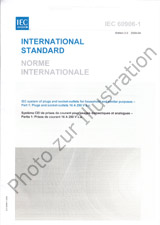Wir benötigen Ihre Einwilligung zur Verwendung der einzelnen Daten, damit Sie unter anderem Informationen zu Ihren Interessen einsehen können. Klicken Sie auf "OK", um Ihre Zustimmung zu erteilen.

IEC/TS 62882-ed.1.0
Hydraulic machines - Francis turbine pressure fluctuation transposition
Name übersetzen
NORM herausgegeben am 18.9.2020
Informationen über die Norm:
Bezeichnung normen: IEC/TS 62882-ed.1.0
Ausgabedatum normen: 18.9.2020
SKU: NS-1006080
Zahl der Seiten: 152
Gewicht ca.: 487 g (1.07 Pfund)
Land: Internationale technische Norm
Kategorie: Technische Normen IEC
Kategorie - ähnliche Normen:
Die Annotation des Normtextes IEC/TS 62882-ed.1.0 :
IEC/TS 62882:2020(E) which is a Technical Specification, provides pressure fluctuation transposition methods for Francis turbines and pump-turbines operating as turbines, including: - description of pressure fluctuations, the phenomena causing them and the related problems; - characterization of the phenomena covered by this document, including but not limited to inter-blade vortices, draft tube vortices rope and rotor-stator interaction; - demonstration that both operating conditions and Thoma numbers (cavitation conditions) are primary parameters influencing pressure fluctuations; - recommendation of ways to measure and analyse pressure fluctuations; - identification of potential resonances in test rigs and prototypes; - identification of methods, to transpose the measurement results from model to prototype or provide ways to predict pressure fluctuations in prototypes based on statistics or experience; - recommendation of a data acquisition system, including the type and mounting position of model and prototype transducers and to define the similitude condition between model and prototype; - presentation of pressure fluctuation measurements comparing the model turbine and the corresponding prototype; - discussion of parameters used for the transposition from model to prototype, for example, the peak to peak value at 97 % confidence interval, the RMS value or the standard deviation in the time domain and the relation of main frequency and the rotational frequency in the frequency domain obtained by FFT; - discussion of the uncertainty of the pressure fluctuation transposition from model to prototype; - discussion of factors which influence the transposition, including those which cannot be simulated on the model test rig such as waterway system and mechanical system; - establishment of the transposition methods for different types of pressure fluctuations; - suggestion of possible methods for mitigating pressure fluctuation; - definition of the limitations of the specification. This document is limited to normal operation conditions. Hydraulic stability phenomena related to von Karman vortices, transients, runaway speed and speed no load are excluded from this document. This document provides means to identify potential resonances in model test rigs and prototype turbines. Scaling-up resonance conditions are not treated in this document. When resonance exists, the transposition methods identified in this document do not apply. Under these conditions, the relationship between model and prototype pressure fluctuations cannot be determined. This document is concerned neither with the structural details of the machines nor the mechanical properties of their components, so long as these characteristics do not affect model pressure fluctuations or the relationship between model and prototype pressure fluctuations.
Empfehlungen:
Aktualisierung der Gesetze
Wollen Sie sich sicher sein, dass Sie nur die gültigen technischen Vorschriften verwenden?
Wir bieten Ihnen Lösungen, damit Sie immer nur die gültigen (aktuellen) legislativen Vorschriften verwenden könnten.
Brauchen Sie mehr Informationen? Sehen Sie sich diese Seite an.



 Cookies
Cookies
